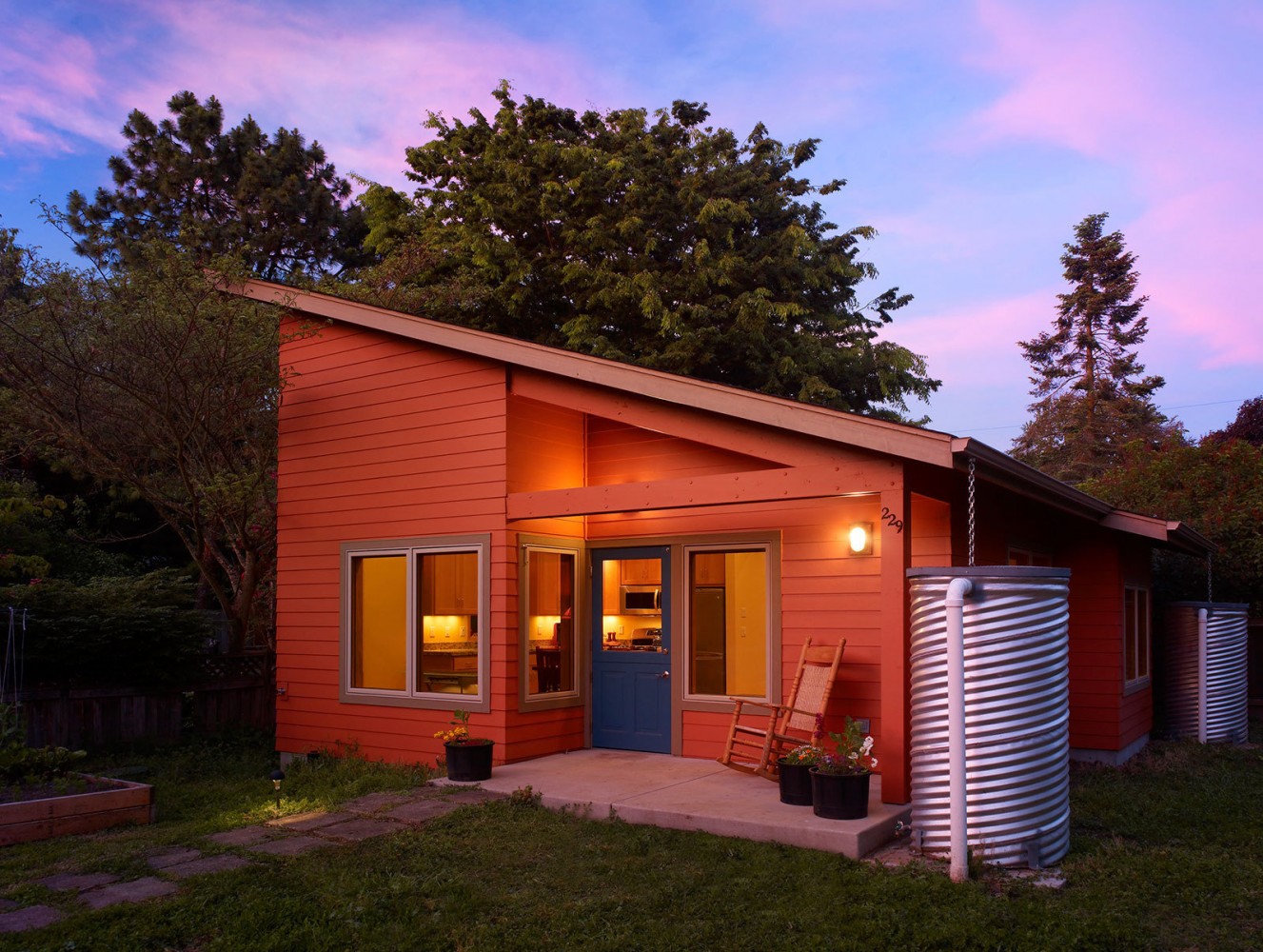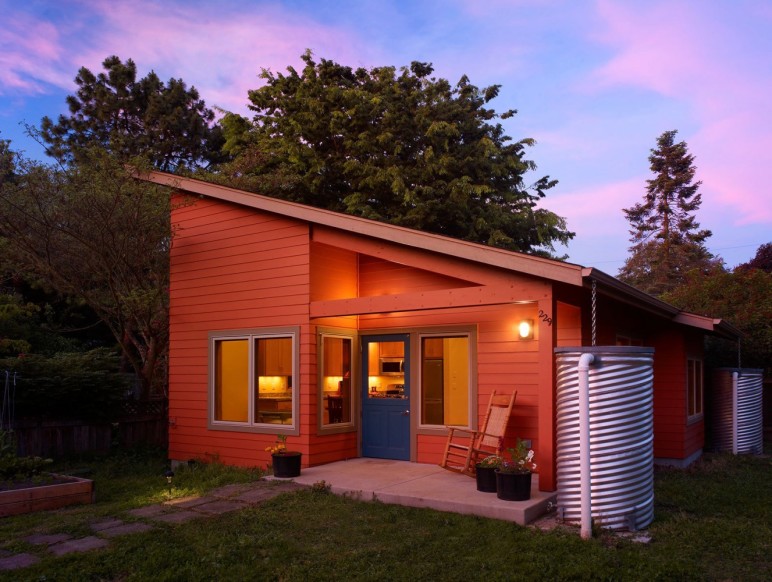The compact size of these unassuming homes makes them remarkably energy efficient, cutting lifetime CO2 emissions by as much as 40 percent as compared with medium sized single-family homes.
Accessory dwelling units (ADUs) are a tool in the fight against climate change. Garden suites, mother-in-law apartments, and backyard cottages—the compact size of these unassuming homes makes them remarkably energy efficient, cutting lifetime CO2 emissions by as much as 40 percent as compared with medium sized single-family homes.
Yet many of Cascadia’s cities maintain policies that pose major barriers to ADU construction, keeping this green housing option scarce. In Seattle, for example, ADUs face obstacles from height and size restrictions, parking requirements, regulations that mandate owner occupancy, among others. These barriers force climate-conscious Cascadians who may prefer a small housing choice to swell their carbon footprints in engorged homes. In Seattle at least, there may be hope on the horizon: the city council will have the opportunity to strike down some of these ADU barriers later this year, giving Seattleites more opportunities to choose green.
Small homes are greener
A 2010 Oregon Department of Environmental Quality report found that a typically sized new single-family home (defined as about 2,300 square feet) built to industry standards is responsible for nearly 60 percent more emissions than a home approximately half its size over the course of an average 70-year home lifespan, from construction to demolition.
As the figure below shows, the difference in climate impact is almost entirely from reduced energy needs during occupancy, for things like temperature control and lighting. A small portion of the energy savings for the small home also accrue from reduced material fabrication and transport, as compared with those of more average-sized homes. (This chart and the next measure climate impact in metric tons of carbon dioxide equivalent emissions. This is a common unit of measurement in studies of emissions, which combines total effect of emissions from all greenhouse gases.)

Original Sightline Institute graphic, available under our free use policy.
In fact, going small can have even better climate benefits than many green building practices. The same Oregon DEQ report compared energy consumption of an extra-small home (1,149 square feet) constructed according to standard building practices with that of average size homes constructed according to two popular green building philosophies: high insulation and optimized building material disposal. Green building practices and standards have come a long way since 2010, but at the time the extra-small home saved significantly more energy than the green homes. As the chart below shows, over a typical 70-year home lifespan, an extra-small home is responsible for 150 metric tons fewer CO2 emissions than a medium size high insulation home. That’s approximately the emissions from 36 average passenger vehicles over a full year of driving. The small home outperformed the optimized material end-of-life home by even more, emitting a full 212 fewer metric tons CO2 over the 70-year home lifecycle.
(The high insulation home, termed the high performance shell home in the DEQ report, was modeled after the Oregon High Performance Home (HPH) standard at the time and focused on improved ceiling, wall, and floor insulation, as well as reduced heat loss through windows. The optimized end-of-life home scenario focused on best recycling practices for all non-wood building materials and energy recovery from all wooden building materials. More detailed construction specifications of both green building practices begin on page 12 of the report.)

Original Sightline Institute graphic, available under our free use policy.
The energy savings from small homes in multi-family buildings—such as apartments, stacked flats, rowhouses, and townhomes—are even higher. That’s because the shared walls cut down not only on building materials, but also energy use during occupancy.

Original Sightline Institute graphic, available under our free use policy.
But a small home is hard to find
Unfortunately, small homes are a scarce commodity in much of Cascadia, and particularly in Seattle. Seattleites’ appetite for more space has steadily swelled since the 1950s and builders have accommodated, building larger homes every year since. Between 1900 and 1950, average new single-family home size in the Emerald City hovered below 2,000 square feet, with 16 percent of new homes measuring less than 1,000 square feet. This size diversity gave Seattle residents abundant small housing options.
Seattle’s average new single-family home size crossed the 2,000 square foot threshold in 1956, and it’s never looked back. Since then, builders have added an average of nearly 20 square feet per year to new homes. New home square footage shrunk slightly during the 2008 economic recession, but it has continued to hover just under 3,000 square feet since then. This is largely because builders have been constructing a larger share of Seattle’s new single-family homes on small, subdivided lots in the city’s multi-family zones. Though this constricts the maximum allowable home square footage, it is a response to many Seattleites’ continued hunger for four walls of their own.

Original Sightline Institute graphic, available under our free use policy.
As houses grow larger, the share of single-family homes under 1,000 square feet is shrinking dramatically: since 1956 builders have constructed just 3 percent of new single-family homes under the 1,000 square foot mark. And the squeeze over the last decade has been particularly fierce: Seattle has added fewer than 160 single-family homes under 1,000 square feet since 2008. This steady trend to supersize homes not only raises prices, but also slashes choice for households that want to go small for environmental, or personal reasons.

Original Sightline Institute graphic, available under our free use policy.
But even with that, Seattle has experienced a mini revival of smaller housing options since 2000, evident in the small post-2008 uptick in the chart above. In addition to the slightly increased selection of single-family homes under the 1,000 square foot mark added to Seattle’s housing stock over the last decade, the city has also seen a broader selection of small housing choices in other housing types. These include a shrinking average new apartment size (in 2017 the average size of a new construction apartment in Seattle was 635 square feet), nearly 300 new townhomes built under 1000 square feet, plus a net gain of 816 ADUs and DADUs (built between 2008 and 2016), and the short-lived revival of micro-apartments from 2009 to 2014.
ADUs offer a return to small and green
As Seattle’s stock of small home options in its single-family zones shrinks every year, so does its energy-smart housing stock. ADUs could change this, offering Cascadians interested in green housing more home choices in neighborhoods across the city. The climate benefits of ADUs accrue not only from their compact size, and attendant slashed heating, cooling, and lighting bills, but also from reductions in building materials. Attached accessory dwellings in particular, like basement apartments or above-garage units, can take advantage of existing materials and structures, thereby cutting energy costs from material manufacture, transport, and construction even further. In addition, most Cascadian cities, including Seattle, regulate ADU size to 1,000 square feet or less, even smaller than the small home the Oregon DEQ studied. This suggests the climate savings of an ADU compared to a medium sized new homes would be even greater than in the report.
Seattle can take simple steps to green its housing stock
Portland’s relaxation of its ADU regulation obstacle course shows that reducing policy barriers can in fact facilitate growth of this housing type. Since the city eliminated its ADU parking requirement and development fees in 2010, it’s seen annual ADU permits grow astronomically. In 2010 the city issued fewer than 100 ADU permits; in 2016 the city issued over 600 permits.
Seattle’s city council could do the same for Seattleites this year, growing the Emerald City’s green housing stock and giving more households the option to live green. Council members will have the opportunity to remove four specific barriers that hinder this green housing option: requirements for off-street parking and owner occupancy, the one accessory dwelling unit per lot limit, and restrictive construction mandates, including height, size, and setback standards.
Removing these building barriers and giving Seattle landowners the freedom to build accessory dwelling units as they please would help the Emerald City live up to its name, with abundant green housing options for its climate-conscious residents.
Methods
The energy consumption estimates for a medium sized newly built single-family home come from a 2010 Oregon Department of Environmental Quality report. This report calculated the lifetime energy consumption of a home close to the average market size for new homes in Oregon, built according to current industry standards and practices.












Charles (Charlie) Sax, Architect
A resource which may be of interest:
ADUdesigns.com
Barb
As a homeowner, I just want to live is relative peace and quiet. The house next door has added an ADU in the back and even though the law here is that owner must occupy, the owner never has lived there. They were or are kind of scofflaws.
They get around the law by renting both places to a father and a son, or relatives or something like that. There has been a lot of trouble with code compliance officers visiting, people renting the place with motorcycle maintenance hobbies, Brooom, brooom, junker trucks all over, yapping dogs at all hours, screaming kids and parents, and the beep, beep, beep of U-Haul trucks pulling in and out. Every few months or years, we wonder what are we going to have to deal with now as new people move in and don’t care a whit about the neighbors or neighborhood.
This is why people resist the idea.
GP
It’s definitely a good tool, but it isn’t going to help a huge amount. There simply won’t be a lot of units added. How many people want to both build an ADU and, most of all, be a landlord, with a tenant who you can’t get away from because they are right there in your basement or back yard?
Al Johnson
Good piece, but it should be updated to address the new Oregon statute requiring local governments to remove barriers to ADUs in urban residential zones by July 1, 2018. The Oregon Department of Land Conservation and Development has issued an informal guidance paper, which can be found at this link:
https://www.oregon.gov/LCD/docs/ADU_Guidance_DLCD_Final.pdf
Here are a few excerpts from the guidance. It is nonbinding, but helpful pending expected litigation over some of the statute’s terminology.
Introduction
As housing prices in Oregon go up, outpacing employment and wage growth, the availability of affordable housing is decreasing in cities throughout the state. While Oregon’s population continues to expand, the supply of housing, already impacted by less building during the recession, has not kept up. To address the lack of housing supply, House Speaker Tina Kotek introduced House Bill 2007 during the 2017 legislative session to, as she stated, “remove barriers to development.” Through the legislative process, legislators placed much of the content of House Bill 2007 into Senate Bill 1051, which then passed, and was signed into law by Governor Brown on August 15, 2017. In addition, a scrivener’s error1 was corrected through the passage of HB 4031 in 2018. Among the provisions of SB 1051 and HB 4031 is the requirement that cities and counties of a certain population allow accessory dwelling units (ADUs) as described below: a) A city with a population greater than 2,500 or a county with a population greater than 15,000 shall allow in areas within the urban growth boundary that are zoned for detached singlefamily dwellings the development of at least one accessory dwelling unit for each detached single‐family dwelling, subject to reasonable local regulations relating to siting and design. b) As used in this subsection, “accessory dwelling unit” means an interior, attached or detached residential structure that is used in connection with or that is accessory to a single‐family dwelling. This new requirement becomes effective on July 1, 2018 and subject cities and counties must accept applications for ADUs inside urban growth boundaries (UGBs) starting July 1, 2018.
Guidance by Topic
The purpose of the following guidance is to help cities and counties implement the ADU requirement in a manner that meets the letter and spirit of the law: to create more housing in Oregon by removing barriers to development.
Number of Units The law requires subject cities and counties to allow “at least one accessory dwelling unit for each detached single‐family dwelling.” While local governments must allow one ADU where required, DLCD encourages them to consider allowing two units. For example, a city or county could allow one detached ADU and allow another as an attached or interior unit (such as a basement conversion). Because ADUs blend in well with single‐family neighborhoods, allowing two units can help increase housing supply while not having a significant visual impact. Vancouver, BC is a successful example of such an approach.
Siting Standards
In order to simplify standards and not create barriers to development of ADUs, DLCD recommends applying the same or less restrictive development standards to ADUs as those for other accessory buildings. Typically that would mean that an ADU could be developed on any legal lot or parcel as long as it met the required setbacks and lot coverage limits; local governments should not mandate a minimum lot size for ADUs. So that lot coverage requirements do not preclude ADUs from being built on smaller lots, local governments should review their lot coverage standards to make sure they don’t create a barrier to development.
To address storm water concerns, consider limits to impermeable surfaces rather than simply coverage by structures.
In addition, any legal nonconforming structure (such as a house or outbuilding that doesn’t meet current setback requirements) should be allowed to contain, or be converted to, an ADU as long as the development does not increase the nonconformity.
Design Standards
Any design standards required of ADUs must be clear and objective (ORS 197.307[4]). Clear and objective standards do not contain words like “compatible” or “character.” With the exception of ADUs that are in historic districts and must follow the historic district regulations, DLCD does not recommend any special design standards for ADUs. Requirements that ADUs match the materials, roof pitch, windows, etc. of the primary dwelling can create additional barriers to development and sometimes backfire if the design and materials of the proposedADU would have been of superior quality to those of the primary dwelling, had they been allowed.
Parking
Requiring off‐street parking is one of the biggest barriers to developing ADUs and it is recommended that jurisdictions not include an off‐street parking requirement in their ADU standards. Adding off‐street parking on many properties, especially in older centrally‐located areas where more housing should be encouraged, is often either very expensive or physically impossible. In addition, when adding an additional off‐street parking space requires a new or widened curb cut, it removes existing on‐street parking, resulting in no net gain of parking supply. As an alternative to requiring off‐street parking for ADUs, local governments can implement a residential parking district if there is an on‐street parking supply shortage. For more help on parking issues, visit www.oregon.gov/lcd/tgm/pages/parking.aspx or contact DLCD.
Owner Occupancy
Owner‐occupancy requirements, in which the property owner is required to live on the property in either the primary or accessory dwelling unit, are difficult to enforce and not recommended. They may be a barrier to property owners constructing ADUs, but will more likely simply be ignored and constitute an on‐going enforcement headache for local governments.
Public Utilities
Development codes that require ADUs to have separate sewer and water connections create barriers to building ADUs. In some cases, a property owner may want to provide separate connections, but in other cases doing so may be prohibitively expensive.
pamela krause
YES! Thank You. We Must Stop projecting Our Personal Inner Space Needs onto the Land.
This is Destructive Greed and Relinguishes Ethics and Responsibility for Community
and Our Earth Home